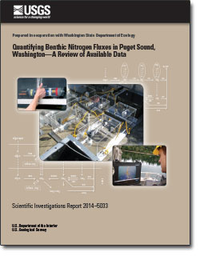Understanding benthic fluxes is important for understanding the fate of materials that settle to the Puget Sound, Washington, seafloor, as well as the impact these fluxes have on the chemical composition and biogeochemical cycles of marine waters. Existing approaches used to measure benthic nitrogen flux in Puget Sound and elsewhere were reviewed and summarized, and factors for considering each approach were evaluated. Factors for selecting an appropriate approach for gathering information about benthic flux include: availability of resources, objectives of projects, and determination of which processes each approach measures. An extensive search of literature was undertaken to summarize known benthic nitrogen fluxes in Puget Sound. A total of 138 individual flux chamber measurements and 38 sets of diffusive fluxes were compiled for this study. Of the diffusive fluxes, 35 new datasets were located, and new flux calculations are presented in this report. About 65 new diffusive flux calculations are provided across all nitrogen species (nitrate, NO3-; nitrite, NO2-; ammonium, NH4+). Data analysis of this newly compiled benthic flux dataset showed that fluxes beneath deep (greater than 50 meters) water tended to be lower than those beneath shallow (less than 50 meters) water. Additionally, variability in flux at the shallow depths was greater, possibly indicating a more dynamic interaction between the benthic and pelagic environments. The overall range of bottom temperatures from studies in the Puget Sound area were small (5–16 degrees Celsius), and only NH4+ flux showed any pattern with temperature. For NH4+, flux values and variability increased at greater than about 12 degrees Celsius. Collection of additional study site metadata about environmental factors (bottom temperature, depth, sediment porosity, sediment type, and sediment organic matter) will help with development of a broader regional understanding benthic nitrogen flux in the Puget Sound.


